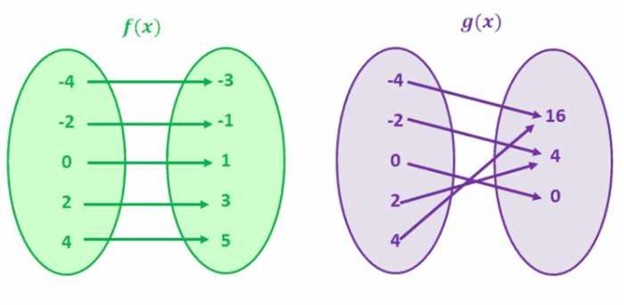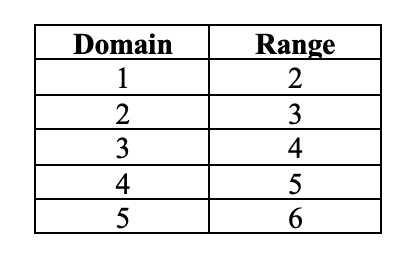One to One Functions - Graph, Examples | Horizontal Line Test
What is a One to One Function?
A one-to-one function is a mathematical function where each input correlates to just one output. So, for each x, there is only one y and vice versa. This implies that the graph of a one-to-one function will never intersect.
The input value in a one-to-one function is noted as the domain of the function, and the output value is the range of the function.
Let's examine the examples below:

For f(x), any value in the left circle correlates to a unique value in the right circle. Similarly, every value on the right side corresponds to a unique value on the left. In mathematical terms, this means that every domain has a unique range, and every range owns a unique domain. Thus, this is an example of a one-to-one function.
Here are some more representations of one-to-one functions:
-
f(x) = x + 1
-
f(x) = 2x
Now let's examine the second picture, which exhibits the values for g(x).
Pay attention to the fact that the inputs in the left circle (domain) do not hold unique outputs in the right circle (range). For example, the inputs -2 and 2 have the same output, i.e., 4. Similarly, the inputs -4 and 4 have equal output, i.e., 16. We can see that there are equivalent Y values for numerous X values. Thus, this is not a one-to-one function.
Here are some other representations of non one-to-one functions:
-
f(x) = x^2
-
f(x)=(x+2)^2
What are the properties of One to One Functions?
One-to-one functions have the following characteristics:
-
The function holds an inverse.
-
The graph of the function is a line that does not intersect itself.
-
They pass the horizontal line test.
-
The graph of a function and its inverse are the same regarding the line y = x.
How to Graph a One to One Function
In order to graph a one-to-one function, you are required to figure out the domain and range for the function. Let's study a simple example of a function f(x) = x + 1.

Immediately after you possess the domain and the range for the function, you ought to plot the domain values on the X-axis and range values on the Y-axis.
How can you determine if a Function is One to One?
To test whether or not a function is one-to-one, we can use the horizontal line test. Immediately after you graph the graph of a function, trace horizontal lines over the graph. In the event that a horizontal line passes through the graph of the function at more than one point, then the function is not one-to-one.
Since the graph of every linear function is a straight line, and a horizontal line doesn’t intersect the graph at more than one point, we can also deduct all linear functions are one-to-one functions. Keep in mind that we do not apply the vertical line test for one-to-one functions.
Let's look at the graph for f(x) = x + 1. As soon as you chart the values of x-coordinates and y-coordinates, you need to examine if a horizontal line intersects the graph at more than one point. In this case, the graph does not intersect any horizontal line more than once. This means that the function is a one-to-one function.

On the other hand, if the function is not a one-to-one function, it will intersect the same horizontal line more than one time. Let's study the diagram for the f(y) = y^2. Here are the domain and the range values for the function:

Here is the graph for the function:

In this instance, the graph meets multiple horizontal lines. For example, for both domains -1 and 1, the range is 1. Similarly, for either -2 and 2, the range is 4. This signifies that f(x) = x^2 is not a one-to-one function.
What is the inverse of a One-to-One Function?
Considering the fact that a one-to-one function has just one input value for each output value, the inverse of a one-to-one function is also a one-to-one function. The opposite of the function essentially undoes the function.
For example, in the event of f(x) = x + 1, we add 1 to each value of x in order to get the output, i.e., y. The inverse of this function will deduct 1 from each value of y.
The inverse of the function is denoted as f−1.
What are the qualities of the inverse of a One to One Function?
The characteristics of an inverse one-to-one function are the same as any other one-to-one functions. This means that the opposite of a one-to-one function will hold one domain for each range and pass the horizontal line test.
How do you find the inverse of a One-to-One Function?
Determining the inverse of a function is simple. You just need to swap the x and y values. For example, the inverse of the function f(x) = x + 5 is f-1(x) = x - 5.

Just like we reviewed earlier, the inverse of a one-to-one function reverses the function. Since the original output value showed us we needed to add 5 to each input value, the new output value will require us to delete 5 from each input value.
One to One Function Practice Examples
Contemplate the following functions:
-
f(x) = x + 1
-
f(x) = 2x
-
f(x) = x2
-
f(x) = 3x - 2
-
f(x) = |x|
-
g(x) = 2x + 1
-
h(x) = x/2 - 1
-
j(x) = √x
-
k(x) = (x + 2)/(x - 2)
-
l(x) = 3√x
-
m(x) = 5 - x
For each of these functions:
1. Identify whether or not the function is one-to-one.
2. Draw the function and its inverse.
3. Determine the inverse of the function numerically.
4. Specify the domain and range of each function and its inverse.
5. Use the inverse to determine the value for x in each calculation.
Grade Potential Can Help You Learn You Functions
If you are facing difficulties trying to understand one-to-one functions or similar topics, Grade Potential can put you in contact with a private tutor who can help. Our Marietta math tutors are experienced educators who support students just like you enhance their understanding of these concepts.
With Grade Potential, you can learn at your unique pace from the convenience of your own home. Schedule a call with Grade Potential today by calling (770) 637-7308 to learn more about our tutoring services. One of our representatives will contact you to better ask about your requirements to find the best instructor for you!




